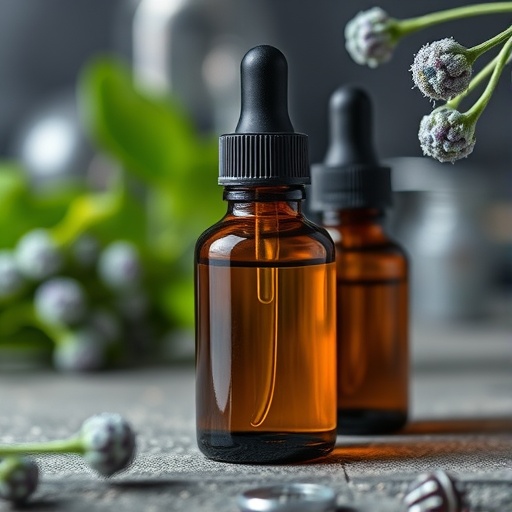In the relentless battle against foodborne bacteria, scientists have turned a focused eye toward nature, exploring the expansive world of essential oils as promising antibiofilm agents. Recent breakthroughs in microbiology have revealed that essential oils, long celebrated for their aromatic qualities, possess powerful capabilities in disrupting and preventing the formation of bacterial biofilms—complex, structured communities that shield pathogens from conventional antimicrobial treatments. This burgeoning field of research, documented extensively in a 2025 review published in Food Science and Biotechnology, sheds light on the sophisticated mechanisms through which essential oils combat bacterial colonization on food surfaces, potentially revolutionizing food safety and public health.
Biofilms formed by foodborne pathogens represent a formidable challenge in the food industry due to their inherent resistance to chemical disinfectants and antibiotics. These microbial fortresses not only protect bacteria from external threats but also facilitate persistent contamination, leading to spoilage, decreased shelf life, and severe outbreaks of foodborne illnesses. The quest to identify natural and effective antibiofilm agents has propelled essential oils to the forefront. Extracted from aromatic plants, these oils contain a complex mixture of bioactive compounds that interfere with bacterial communication, adhesion, and metabolism, effectively destabilizing biofilms’ structural integrity.
A critical aspect of essential oils’ antimicrobial prowess lies in their ability to disrupt quorum sensing, a bacterial cell-to-cell communication system that regulates biofilm formation and virulence factors. By interfering with quorum sensing molecules, essential oils can inhibit the coordinated behavior necessary for biofilm maturation. This mechanism deprives foodborne bacteria of their ability to organize into protective biofilms, rendering them more susceptible to eradication. Scientific investigations highlight components such as thymol, carvacrol, eugenol, and cinnamaldehyde as particularly potent in targeting quorum sensing pathways.
Moreover, essential oils impart direct damage to bacterial cell membranes. Their lipophilic nature allows them to penetrate and destabilize the lipid bilayer, increasing membrane permeability and causing leakage of cellular contents. This disruption compromises bacterial viability and inhibits further biofilm development. Studies demonstrate that the efficacy of essential oils against biofilms is dose-dependent, with higher concentrations exhibiting pronounced bactericidal effects without fostering resistance, a common issue plaguing traditional antibiotic therapies.
Beyond their actions on individual cells, essential oils also impede the initial adhesion phase of biofilm formation. Bacterial attachment to food contact surfaces is the first critical step in biofilm development. Hydrophobic and electrostatic interactions govern this attachment, and essential oils can modulate these forces, making surfaces less conducive to bacterial colonization. Experimental results reveal a marked reduction in adhesion rates when surfaces are treated with essential oil formulations, offering a proactive strategy to prevent biofilm establishment from the outset.
The potential applications of essential oils in food preservation are vast and compelling. Integration into food packaging materials, surface sanitizers, and washing agents introduces a natural safeguard, mitigating microbial contamination while aligning with consumer demand for clean-label and chemical-free food products. However, challenges remain in optimizing the stability, sensory impact, and controlled release of essential oils to maintain antimicrobial activity without altering food qualities adversely.
Recent advances in nanotechnology further augment the functionality of essential oils. Encapsulation techniques involving nanoparticles improve the solubility and thermal stability of essential oils, enhancing their sustained release and targeted delivery to biofilm sites. These innovations not only strengthen the antibiofilm efficacy but also minimize sensory alterations, broadening the scope for industrial adoption. Laboratory models simulating food processing environments confirm that nano-encapsulated essential oils achieve superior biofilm inhibition compared to their unmodified counterparts.
From a mechanistic perspective, the synergistic interactions among multiple essential oil components contribute to their broad-spectrum antibiofilm effects. This complex synergy disrupts multiple bacterial targets simultaneously, decreasing the likelihood of resistance development. Comprehensive metabolomic and transcriptomic analyses reveal that essential oils downregulate genes associated with extracellular polymeric substance production—a critical biofilm matrix component—further undermining biofilm structural cohesion.
The environmental friendliness of essential oils is another compelling advantage. Unlike synthetic disinfectants, which may leave harmful residues and contribute to ecological imbalances, essential oils degrade naturally without adverse effects on ecosystems. This sustainability profile fits within a growing paradigm of eco-conscious food safety practices, promoting safer and greener solutions in foodborne pathogen control.
Despite the promising data, translational hurdles still need addressing before widespread industrial implementation. Variability in essential oil composition due to plant source, harvest conditions, and extraction methods can affect reproducibility and efficacy. Standardization protocols and stringent quality control measures are critical to ensure consistent antibiofilm performance. Collaboration between microbiologists, food technologists, and chemical engineers will be pivotal in overcoming these challenges.
In clinical and regulatory contexts, essential oils as antimicrobial agents require thorough evaluation for safety and efficacy. Although generally recognized as safe (GRAS) by many food safety authorities, detailed toxicological assessments are necessary, particularly concerning chronic exposure and interaction with food components. Such rigorous scrutiny will facilitate their acceptance and integration into food safety guidelines.
The recent surge in multidrug-resistant foodborne pathogens underscores an urgent need for innovative control strategies. Essential oils, with their multifaceted antibiofilm mechanisms, herald a promising avenue to supplement or even replace traditional antimicrobials. Their broad-spectrum activity and natural origin may redefine food safety paradigms, potentially curbing the incidence of contamination and outbreaks worldwide.
In conclusion, the 2025 review consolidates extensive research findings affirming that essential oils possess robust antibiofilm properties against a spectrum of foodborne bacteria. Their capacity to interfere with quorum sensing, disrupt membranes, inhibit adhesion, and degrade biofilm matrices positions them as versatile natural agents in the fight against bacterial biofilms. Continuous advancements in formulation and delivery technologies promise to unlock their full potential, fostering safer food systems and public health outcomes. This evolving landscape invites intensified research efforts to bridge laboratory success with real-world application, marking a crucial step toward harnessing nature’s botanical arsenal in antimicrobial strategies.
Subject of Research: Antibiofilm properties of essential oils against foodborne bacteria
Article Title: Antibiofilm properties of essential oils against foodborne bacteria: a review of mechanisms
Article References:
Kim, JS., Khan, M.S.I., Kim, TY. et al. Antibiofilm properties of essential oils against foodborne bacteria: a review of mechanisms. Food Sci Biotechnol (2025). https://doi.org/10.1007/s10068-025-01988-8
Image Credits: AI Generated




